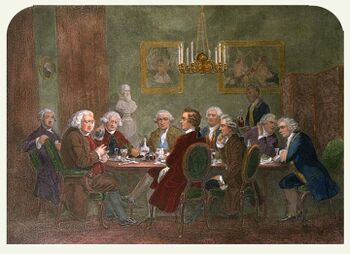Difference between revisions of "User talk:Compactflash Siamendes"
Jump to navigation
Jump to search
| (7 intermediate revisions by 2 users not shown) | |||
| Line 1: | Line 1: | ||
== Cite == | |||
According to scientists, the Sun is pretty big.<ref>E. Miller, The Sun, (New York: Academic Press, 2005), 23-5.</ref> | |||
The Moon, however, is not so big.<ref>R. Smith, "Size of the Moon", Scientific American, 46 (April 1978): 44-6.</ref> | |||
<references/> | |||
< | == ImageMap == | ||
<imagemap> | |||
Image:JoshuaReynoldsParty.jpg|center|Image map example. Clicking on a person in the picture causes the browser to load the appropriate article.|350px|thumb | |||
poly 133 343 124 287 159 224 189 228 195 291 222 311 209 343 209 354 243 362 292 466 250 463 [[w:Samuel Johnson|Dr Johnson - Dictionary writer]] | |||
poly 76 224 84 255 43 302 62 400 123 423 121 361 137 344 122 290 111 234 96 225 [[w:James Boswell|Boswell - Biographer]] | |||
poly 190 276 208 240 229 228 247 238 250 258 286 319 282 323 223 323 220 301 200 295 [[w:Joshua Reynolds|Sir Joshua Reynolds - Host]] | |||
poly 308 317 311 270 328 261 316 246 320 228 343 227 357 240 377 274 366 284 352 311 319 324 [[w:David Garrick|David Garrick - actor]] | |||
poly 252 406 313 343 341 343 366 280 383 273 372 251 378 222 409 228 414 280 420 292 390 300 374 360 359 437 306 418 313 391 272 415 [[w:Edmund Burke|Edmund Burke - statesman]] | |||
rect 418 220 452 287 [[w:Pasquale Paoli|Pasqual Paoli - Corsican patriot]] | |||
poly 455 238 484 253 505 303 495 363 501 377 491 443 429 439 423 375 466 352 [[w:Charles Burney|Charles Burney - music historian]] | |||
poly 501 279 546 237 567 239 572 308 560 326 537 316 530 300 502 289 [[w:Thomas Warton|Thomas Warton - poet laureate]] | |||
poly 572 453 591 446 572 373 603 351 562 325 592 288 573 260 573 248 591 243 615 254 637 280 655 334 705 396 656 419 625 382 609 391 613 453 [[w:Oliver Goldsmith|Oliver Goldsmith - writer]] | |||
rect 450 86 584 188 [[w:Joshua Reynolds|prob.The Infant Academy 1782]] | |||
rect 286 87 376 191 [[w:Joshua Reynolds|unknown painting]] | |||
circle 100 141 20 [[w:Joshua Reynolds|An unknown portrait]] | |||
poly 503 192 511 176 532 176 534 200 553 219 554 234 541 236 525 261 506 261 511 220 515 215 [[w:Francis Barber|servant - poss. Francis Barber]] | |||
rect 12 10 702 500 [[w:The Club (Literary Club)|Use button to enlarge or use hyperlinks]] | |||
desc bottom-left | |||
</imagemap> | |||
== MathStatFunctions == | |||
PI equals {{ #const: pi }} | |||
== ParserFunctions == | |||
{{#if: | yes | no}} | |||
== | == StringFunctions == | ||
{{#explode:And if you tolerate this| |2}} | |||
{{#explode:String/Functions/Code|/|-1}} | |||
{{#explode:Split%By%Percentage%Signs|%|2}} | |||
== SimpleTable == | |||
<tab border=1> | |||
Field 1→Field 2→Field 3 | |||
Field 4→Field 5→Field 6 | |||
Field 7→Field 8→Field 9 | |||
</tab> | |||
== VideoFlash == | |||
<videoflash>11etBfqjbGg</videoflash> | |||
== Widgets == | |||
<div align="center"> | |||
{{#widget:Vimeo | |||
|id=1704553 | |||
|width=400 | |||
|height=300 | |||
}}</div> | |||
== Variables == | |||
{{#vardefine:a|5}} | |||
{{#vardefine:b|3}} | |||
{{#expr:2*{{#var:a}}+{{#var:b}}}} | |||
== Subpages == | |||
Thx, feature works! :-)<br> | |||
Just FYI: the feature has nothing to do with creating subpages or linking to subpages. It's about beeing able to use special mediawiki variables in the main namespace, which give the subpage or the basepage as a result. This is switched off in the main namespace by default (no idea why...). So it works now. See: [[This page might be deleted soon/WEB-897]].<br>Thx for implementing!!! =)<br>[[Image:Zai_signature.png|45px]] '''[[User:Zai Lynch|Lynch]]''' <sup><small>([[User talk:Zai Lynch|talk]]|[[Special:Contributions/Zai Lynch|contribs]])</small></sup> 08:36, 27 February 2009 (UTC) | |||
=== | |||
[[Image: | |||
Latest revision as of 02:39, 24 June 2009
Cite
According to scientists, the Sun is pretty big.[1] The Moon, however, is not so big.[2]
ImageMap
MathStatFunctions
PI equals {{ #const: pi }}
ParserFunctions
no
StringFunctions
you Code Percentage
SimpleTable
<tab border=1> Field 1→Field 2→Field 3 Field 4→Field 5→Field 6 Field 7→Field 8→Field 9 </tab>
VideoFlash
<videoflash>11etBfqjbGg</videoflash>
Widgets
Variables
13
Subpages
Thx, feature works! :-)
Just FYI: the feature has nothing to do with creating subpages or linking to subpages. It's about beeing able to use special mediawiki variables in the main namespace, which give the subpage or the basepage as a result. This is switched off in the main namespace by default (no idea why...). So it works now. See: This page might be deleted soon/WEB-897.
Thx for implementing!!! =)![]() Lynch (talk|contribs) 08:36, 27 February 2009 (UTC)
Lynch (talk|contribs) 08:36, 27 February 2009 (UTC)
